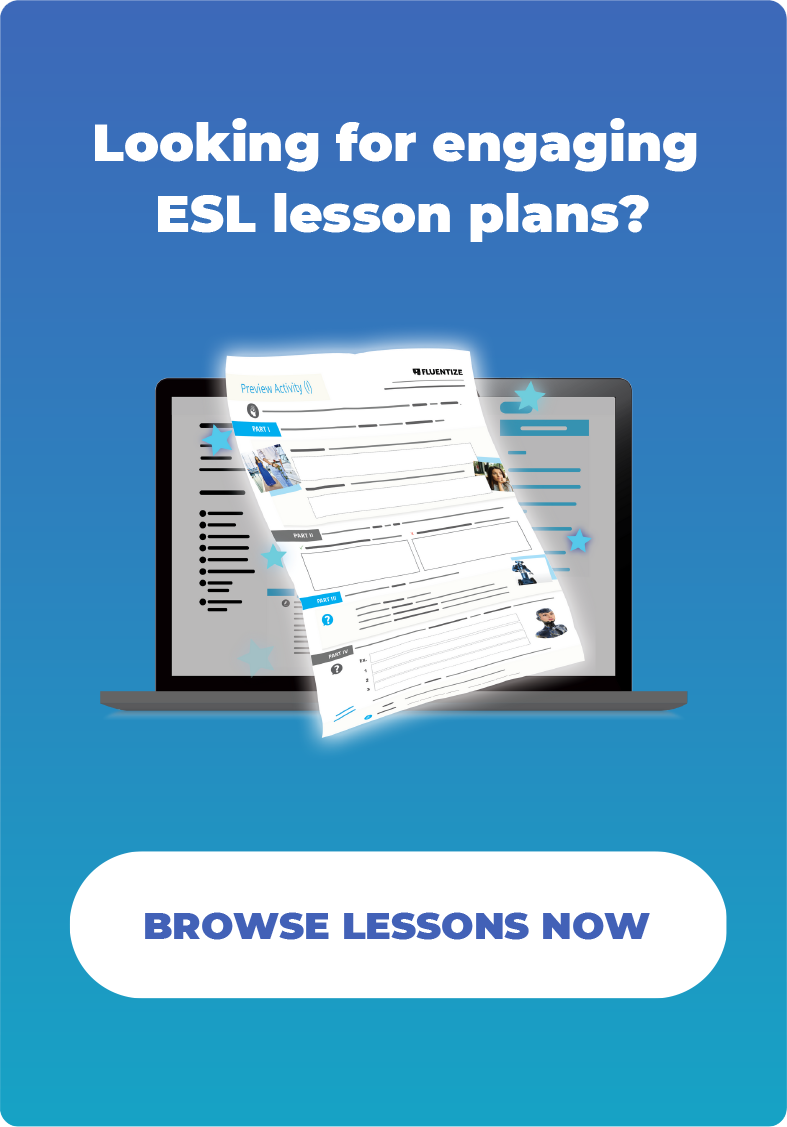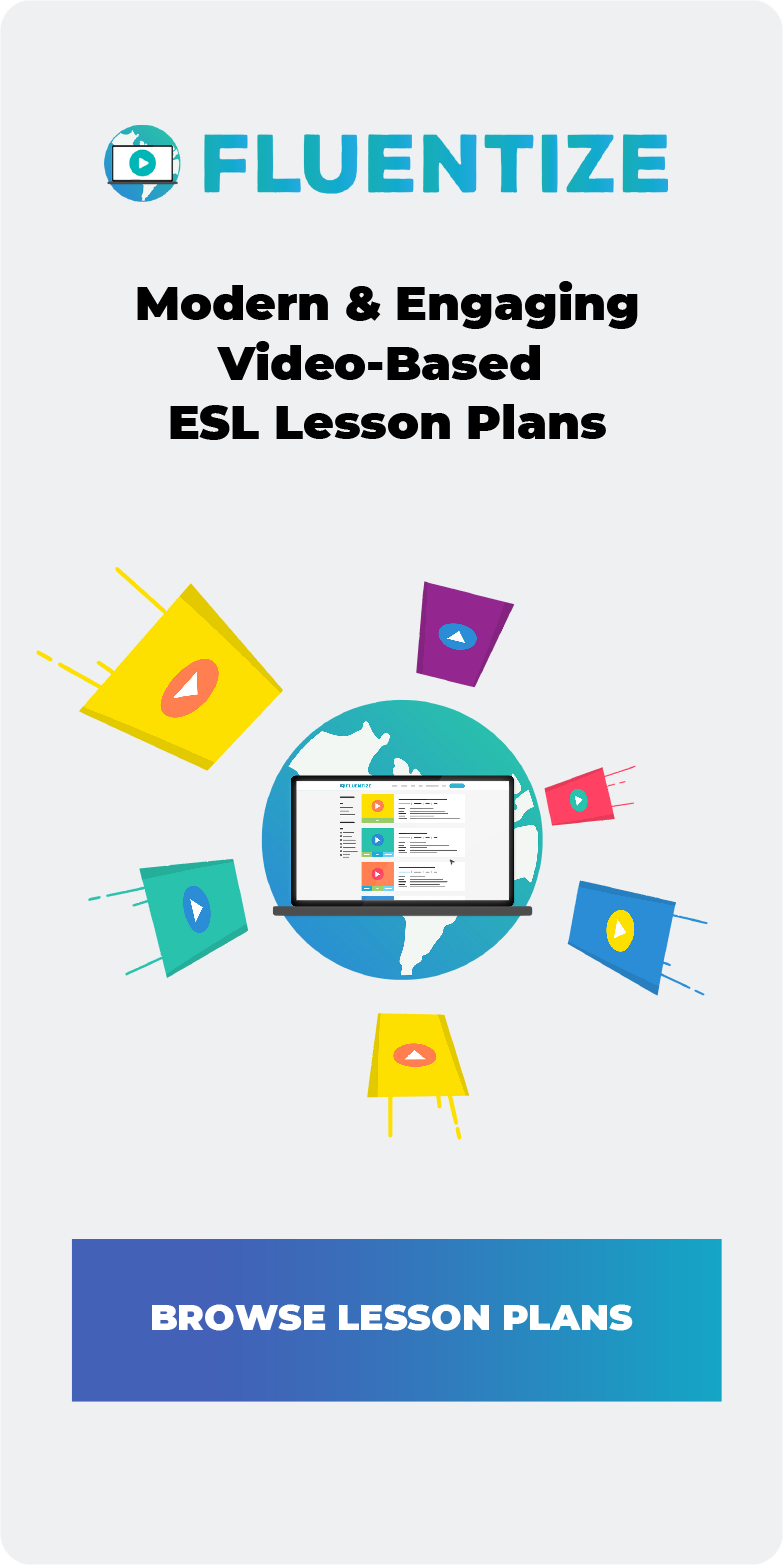I’d like to share personal experience with how to correct ESL students’ errors from a few years ago. I had an advanced student who was fluent, confident, and could discuss anything from politics to cooking. But no matter how many times he heard the word thing, it always sounds like the word “sing”.

“The most important sing in life is family.”
“I have a lot of sings to do today.”
At first, I corrected him. Then his classmates started to notice. Eventually, they just accepted it, and so did he. That’s the problem. When mistakes go unchecked for too long, they become fossilised. They start feeling natural to the learner, making them much harder to fix.
This is why how to correct ESL students’ errors correction matters. But it’s not just about jumping in every time a student slips up. Correcting too much can make them afraid to speak, while too little lets bad habits stick. In this article, we’ll look at different types of mistakes, how to correct ESL students’ errors effectively and how to build a learning environment where errors help students.
Why error correction is important for your ESL students
Picture this: You’ve got a student who always says:
“He go to work at 8.”
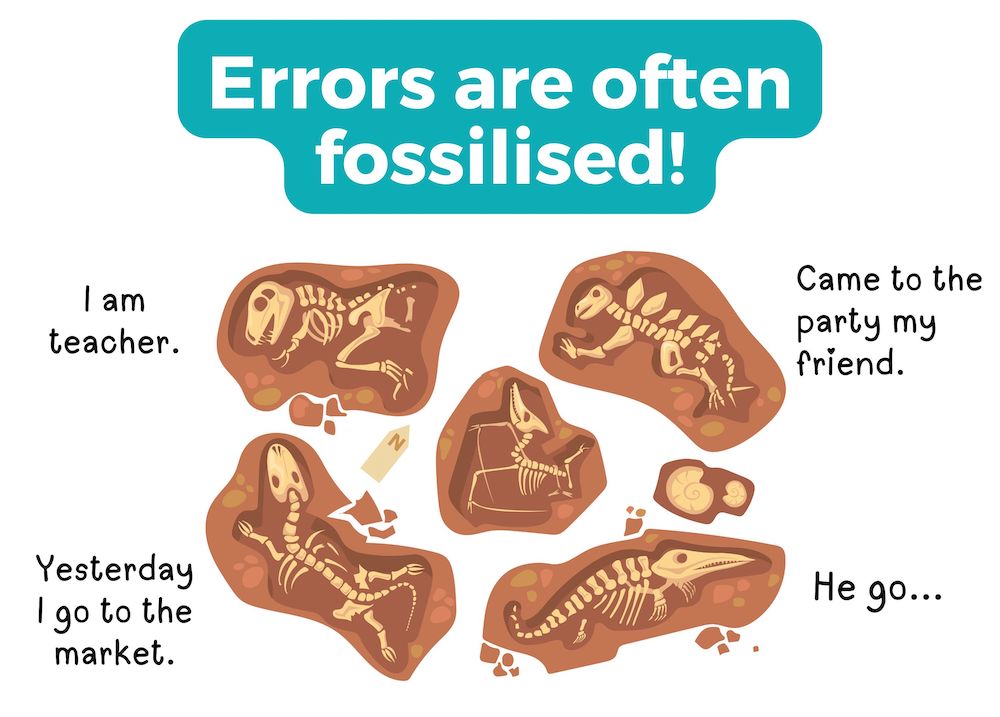
You gently correct them a few times, but they keep making the same mistake.
Fast forward a year, and they’re still saying “He go.” What happened? This is what we call fossilisation, when language errors become so ingrained that they feel natural to the learner, making them tough to fix later on.
Knowing how to correct ESL students’ errors helps prevent fossilisation, keeping students on the right track while boosting their confidence. Think of it like steering a car. Small course corrections early on can prevent a major detour later.
This fear of making mistakes can lead to students holding back in conversations, which is something many of us have seen in the classroom. Language anxiety is a real challenge, and it goes hand in hand with error correction. If you’re interested in strategies to help students feel more comfortable making mistakes and speaking freely, you could learn how to help students overcome foreign language anxiety.
But let’s be clear—knowing how to correct ESL students’ errors doesn’t mean stopping students mid-sentence every time they slip up. Error correction should be strategic, helping students improve without making them afraid to speak. After all, if every time they open their mouth we get correct them, they might just stop trying altogether!
Errors are actually a good sign. They show that students are experimenting with the language. Our job is to guide them, not to scare them into silence. So, instead of thinking of errors as ‘bad’, we should see them as stepping stones to progress.
Common types of mistakes ESL students make
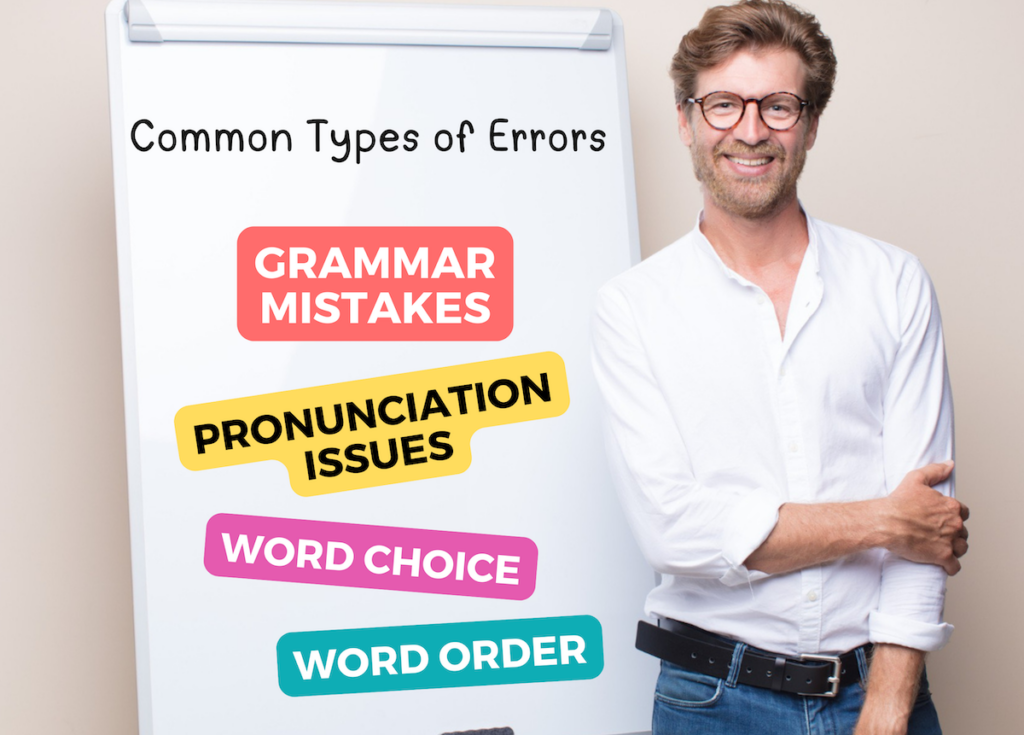
Errors come in all shapes and sizes, and while every learner is unique, certain mistakes tend to pop up more often depending on their first language. That’s because students unconsciously bring patterns from their mother tongue into English, which makes understanding how to correct ESL students’ errors all the more important! Let’s take a look at some common mistake types and what learners from different backgrounds tend to find difficult.
1. Grammar mistakes (a classic for Spanish speakers 🇪🇸)
- “She go to school every day.” (Wrong verb form – it should be goes)
- “I am teacher.” (Missing article – it should be a teacher)
Spanish-speaking students often drop articles (a or the) because Spanish sometimes omits them where English wouldn’t. They might also struggle with subject-verb agreement, as verb endings in Spanish carry more meaning, so the subject is often left out (escribo for I write instead of explicitly saying I write). Knowing how to correct ESL students’ errors in these areas requires clear modeling and guided practice.
💡 Correction tip: Model the correct form and get them to notice the difference themselves. For example, write I am teacher and I am a teacher on the board and ask, “Which one sounds better?”
2. Pronunciation issues (a tricky one for Chinese speakers 🇨🇳)
- “I eat shocolate every day.” (Mixing up /ʃ/ and /ʧ/)
- “The movie was a big heat.” (Confusing /ɪ/ and /iː/ – they meant hit, not heat!)
Many Chinese learners find it hard to distinguish between sounds that don’t exist in Mandarin, like /ʃ/ vs. /ʧ/ (so shoes might sound like choose). Another classic issue is /l/ and /r/ confusion, so rice might come out as lice (which, as you can imagine, can lead to some very unfortunate misunderstandings)
💡 Correction tip: Use minimal pairs (words that differ by just one sound, like ship vs. sheep) and exaggerate the difference. Also, tongue twisters are a fun way to work on these!
3. Lexical (word choice) mistakes (a classic for Brazilian speakers 🇧🇷)
- “I need to make a shower.” (Incorrect collocation – it should be take a shower)
- “My nose is constipated.” (False friend – they meant blocked, not constipated!)
Brazilian Portuguese has a lot of false friends with English, words that look similar but mean different things. For example, constipado in Portuguese means having a blocked nose, but in English, constipated means something very different (let’s just say it involves a different bodily function!). Another common mix-up is collocations, like make a party instead of throw a party.
💡 Correction tip: Instead of just correcting the mistake, give an alternative that sounds more natural. For example, “In English, we don’t make a party, we throw one. Think of it like throwing a ball, you’re sending the party into the world!”
4. Word order errors (a tricky one for German speakers 🇩🇪 or Czech speakers 🇨🇿 )
- “I go always to France on holiday.” (Incorrect word order – it should be I always go to France on holiday)
- “Give me one biscuit!” (Sounds too direct—better to say Could I have a biscuit, please?)
- “Came to the party my friend.” (Czech language word order sometimes puts the verb or object before the subject.)
German speakers often struggle with adverb placement in English. That’s because in German, the verb often comes second, pushing adverbs like always into different positions. They also tend to sound too direct in requests because in German, it’s perfectly normal to say Give me a coffee,but in English that might come across as rude.
💡 Correction tip: Teach chunks of polite language like Could I have… or Would you mind…? and encourage students to listen to how native speakers phrase things.
Where do errors come from?
| Source of error | What is it? | Example |
| Overgeneralisation | Using a rule in places where it doesn’t work | Buyed’ instead of ‘bought’ (thinking all past tense verbs take -ed). |
| Ignorance of rule restrictions | Not knowing that some rules have exceptions | We discussed about the problem’ (adding ‘about’ when it’s not needed). |
| False hypotheses | Guessing a rule but getting it wrong | ‘He was go on holiday’ (thinking ‘was’ and ‘go’ belong together). |
| Simplification | Making language simpler by leaving out or changing words or grammar. | ‘You from where?’ instead of ‘Where are you from?’. |
| Fossilisation | Saying something wrong for so long that it feels right. | ‘I am here since two years’ instead of ‘I’ve been here for two years’.0- |
Understanding how to correct ESL students’ errors is key to helping learners improve. Instead of just pointing out mistakes, teachers need to understand how to correct ESL students’ errors in a way that helps learners notice and fix them on their own. After all, mistakes aren’t just obstacles. They help us understand our students’ thinking!
How to correct ESL students’ errors: on-the-spot vs. delayed correction
How to correct ESL students’ errors is a balancing act. Correct too soon, and students might feel self-conscious. Wait too long, and they may forget the mistake. So, when should you correct immediately, and when should you hold back?
1. On-the-spot correction: when and why?
On-the-spot correction happens right after a mistake. It’s useful when errors cause confusion or when students are practicing a specific structure. If a student says, “Yesterday, I go to the market,” and the focus is past tense, a quick recast – “Oh, you went to the market?” — corrects them naturally.
Pronunciation mistakes? Those generally need quick, on-the-spot correction. If a student says: “I like eating ships” instead of “chips,” you don’t want to let that slide! That said, how you correct matters. A blunt “No, that’s wrong” can discourage students.
Instead, use elicitation: “Do we say ‘I go’ or ‘I went’?” This encourages self-correction, which is more effective. Alternatively, you could use facial expressions or gestures to emphasise or indicate the error, by repeating what the student says, emphasising where the error is, and then shaking your head:
- Student: “Yesterday, I go to the market.”
- Teacher: “Yesterday, I go to the market.”? [shaking your head back and forth]
- Student: “Yesterday, I went to the market.”
On-the-spot correction is best for controlled practice when accuracy matters. But in freer speaking activities, constant correction can kill confidence. That’s where delayed correction comes in.
2. Delayed correction: when and why?
In fluency-based activities like discussions or storytelling, stopping students mid-sentence can disrupt the flow.
Instead, let them finish and correct errors afterward. For example, if a student says: “People should to use less their phone,” stopping them mid-debate to correct this kills momentum.
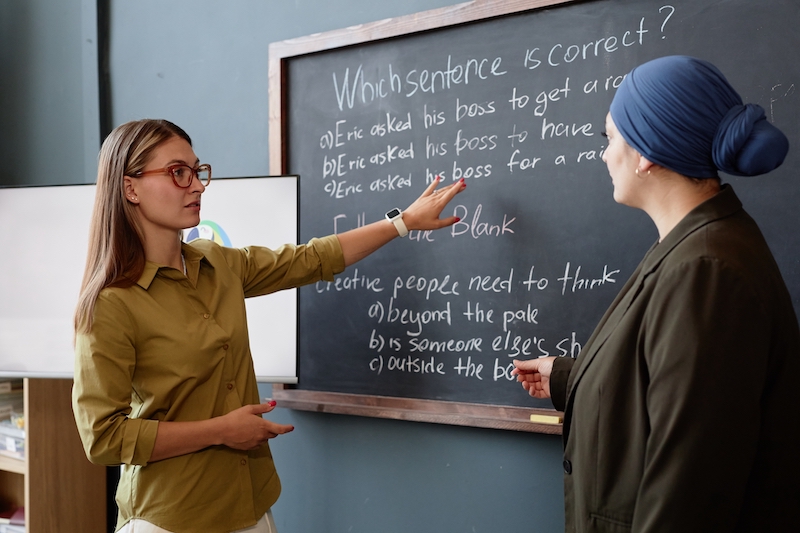
A better approach? Note key mistakes during the lesson and go over them at the end of the lesson. One way to correct ESL students’ errors without disrupting fluency is to write student errors on a piece of paper during the lesson. Then, at the end of the lesson, write them on the board (without names!) and have students correct them together.
Delayed correction also works for writing tasks. Instead of fixing every mistake, underlining errors helps students self-correct, building awareness.
At the end of the day, how to correct ESL students’ errors depends on the activity. Use on-the-spot correction for accuracy-focused tasks and delayed correction for fluency-based activities to keep learning smooth and stress-free.
Finding the right balance when correcting ESL students’ errors
So, should you correct errors right away or wait? The key is knowing what kind of activity is happening and how the student might react.
- Use on-the-spot correction when the goal is accuracy, like grammar drills or pronunciation practice.
- Use delayed correction when the goal is fluency, like debates or storytelling, so students stay focused on expressing their ideas. We don’t want to disrupt the flow!
By choosing the right type of correction at the right moment, you can make how to correct ESL students’ errors both effective and encouraging.
Error Correction Techniques: How to correct ESL Students’ Errors Without Killing Confidence
Now that we’ve covered when to correct errors, let’s look at different ways to do it. There are several techniques that teachers can use when deciding how to correct ESL students’ errors, depending on the type of mistake and student level. Some techniques are gentle and indirect, while others are clear and explicit. The key is knowing which approach works best in different situations.
Recasts
Recasts are when you repeat a student’s incorrect sentence in the correct form. This is done naturally, without directly pointing out the mistake. It allows students to hear the right way to say something without feeling like they are being corrected.
This technique works well when fluency is the focus, as it does not interrupt the flow of conversation. However, because the correction is subtle, students might not always notice the change.
Example:
- Student: “Yesterday I go to the market.”
- Teacher: “Oh, you went to the market. What did you buy?”
Recasts are useful in low-pressure activities, but if a student keeps making the same mistake, a more direct method may be needed.
Elicitation
Elicitation is a technique where you encourage students to correct themselves instead of giving them the answer. Instead of simply stating what is wrong, the teacher hints at the mistake and gives students a chance to fix it on their own.
This helps students develop awareness of language patterns, making them less dependent on the teacher. It is most effective when students already have some knowledge of the target language but need a push to notice errors. Elicitation is great for grammar and vocabulary mistakes but can be frustrating if overused, especially when students genuinely do not know the answer.
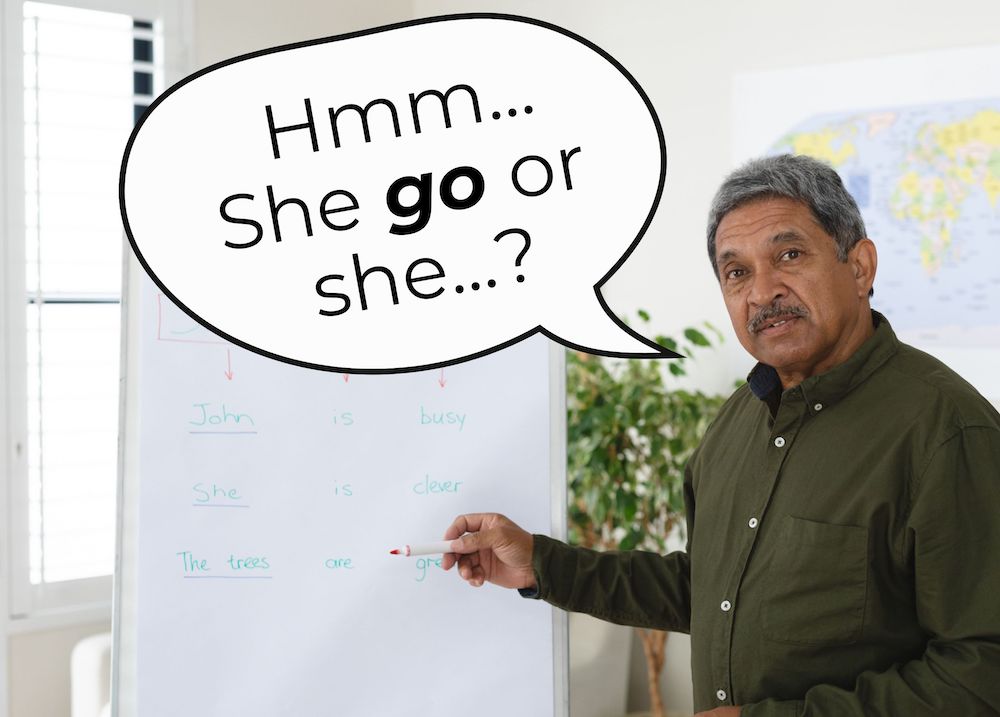
You should try to emphasise verbally where the error is or give some kind of clue.
Example:
- Student: “She go to school every day.”
- Teacher: “Hmm… she go or she…?”
- Student: “Oh! She goes!”
Overall, whether on-the-spot or delayed, your goal should be to elicit the mistake from students instead of outright telling them the error.
Clarification requests
This is when you signal that you didn’t understand a student’s sentence, even if you actually did. This forces the student to rethink and reformulate their sentence. Teachers can use facial expressions or phrases like “Sorry?”, “What do you mean?” or “Could you say that again?” to encourage students to self-correct. It works well in conversations where meaning is more important than accuracy. It helps students become more aware of their mistakes in a natural way.
Example:
- Student: “He have many money.”
- Teacher: “He have…?” (raising eyebrows)
- Student: “He has many… much money!”
Explicit correction
This when you directly point out a student’s mistake and provide the correct form. It works well when teaching new structures and giving clear guidance. It ensures students get the right information but can be discouraging if overused. The solution? A neutral tone helps keep correction effective without making students feel bad.
Example:
- Student: “Yesterday I buyed a book.”
- Teacher: “Actually, the past tense of ‘buy’ is ‘bought’. So, ‘Yesterday I bought a book.'”
Metalinguistic feedback
Metalinguistic feedback is when you give a hint about why a sentence is incorrect instead of providing the answer directly. This can involve short explanations about grammar rules or asking students guiding questions. This is useful for more advanced students who have already been exposed to the rule but need reminders.
Example:
- Student: “He is married with a doctor.”
- Teacher: “Hmm… We don’t say ‘married with‘ in English. Do you remember the correct preposition?”
- Student: “He is married to a doctor!”
Self-correction and peer correction
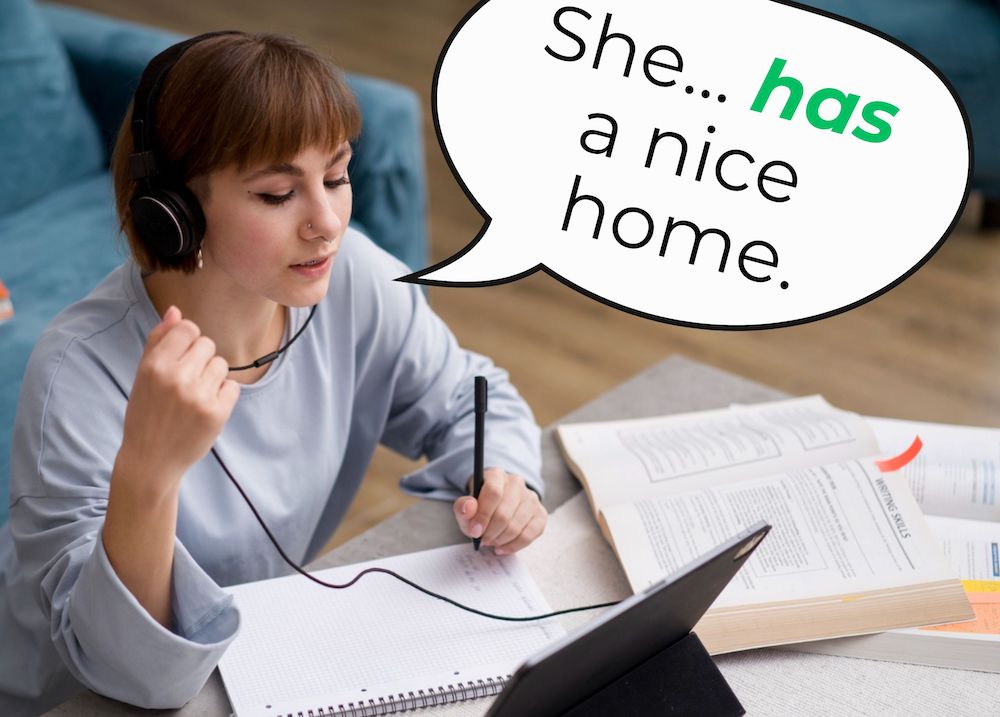
Self-correction happens when students are encouraged to find and fix their own mistakes. Peer correction is when students correct each other’s mistakes instead of waiting for the teacher to step in. Both techniques help students become more independent learners. Instead of always relying on the teacher, they start noticing mistakes themselves. But teachers should be careful with peer correction, as some students may feel uncomfortable correcting or being corrected by classmates.
Example:
- Student 1: “She have a big house.”
- Teacher: “Hmm… she have a big house?”
- Student 1: “She… has?”
- Teacher: “Yes! Well done.”
For peer correction, the teacher can write a mistake on the board and ask the class, “Can anyone help correct this sentence?” This works well in group activities where students feel comfortable helping each other.
Using the board for delayed correction
When students are doing speaking activities, it is often better not to correct them immediately, as this can interrupt their flow.
Instead, the teacher can listen carefully and take notes of common mistakes. After the activity, these mistakes can be written on the board, and students work together to correct them. This technique allows for correction without disrupting fluency and gives students time to reflect on their mistakes. It also encourages group discussion and peer learning.
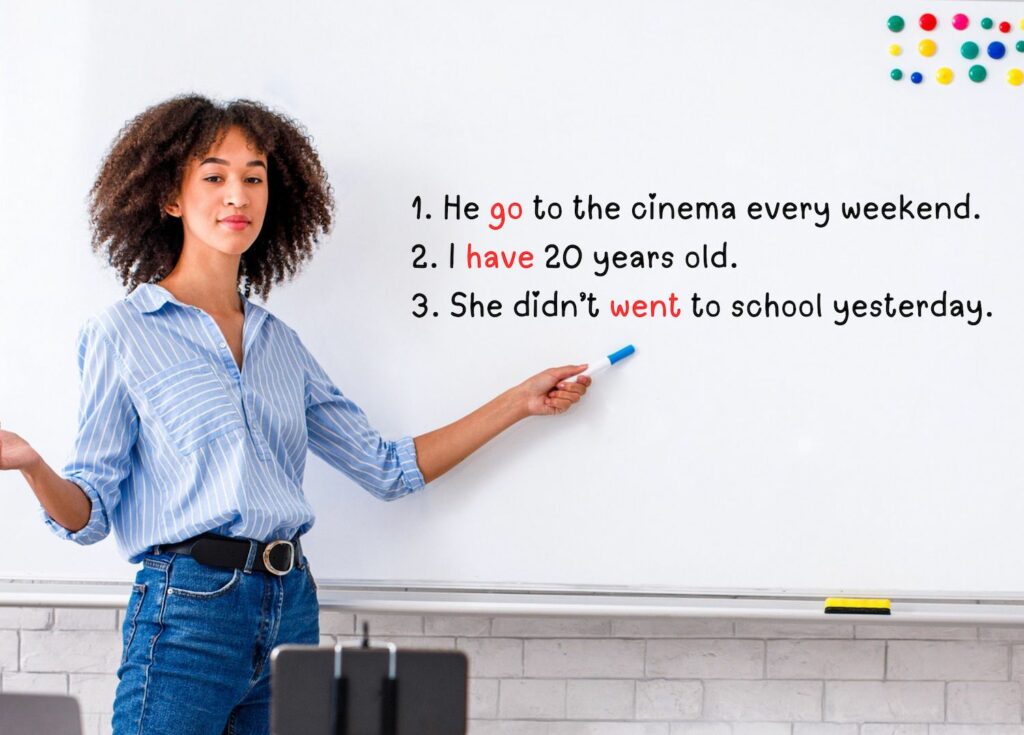
Example:
During a discussion, a teacher hears these mistakes:
- He go to the cinema every weekend.
- I have 20 years old.
- She didn’t went to school yesterday.
At the end of the activity, the teacher writes them on the board and says, “Can you find the mistakes in these sentences?” Students then can work in pairs or groups to correct them, making the activity more interactive.
Here is an example process you could follow for delayed error correction using the board:
- Write the error on the board. “I am graphic designer.”
- Ask students simply: “What’s the mistake?”
- If they still don’t know, you could give a verbal clue, “It needs an article.”
- If that doesn’t help, you can start to give written clues. For example, you could draw an arrow between “am” and “graphic designer”, and ask, “What do we need here?”
- If they still don’t get it, you can simply tell them the error and correct it for them.
💡 Bonus tip! Use a different colour marker or pen to show what or where the error is. It highlights it and helps make the correction stick!
Choosing the Right Error Correction Technique
There is no single best way to correct errors. The most effective method depends on the student, the type of mistake, and the focus of the lesson.
- Use recasts for quick, subtle corrections in conversation.
- Try elicitation and clarification requests to encourage students to think about their mistakes.
- Use explicit correction when teaching new grammar or pronunciation.
- Give metalinguistic feedback to students who need reminders about grammar rules.
- Encourage self-correction and peer correction to help students become more independent.
- Save delayed correction for fluency activities so that students can focus on speaking without constant interruptions.
Correction should help students, not discourage them. The goal is to guide them toward better language use while keeping them engaged and motivated.
How Error Correction Varies Across Proficiency Levels
I still remember a day when I was teaching a group of absolute beginner Turkish students. We were practicing introductions when I heard one student confidently say, “My name Ahmet, I student.” At that moment, I had a choice. I could have stopped him right away and said, “No, Ahmet, you need to say ‘My name is Ahmet, and I am a student.’” But would that have helped? Probably not. If I had overloaded him with too many corrections at once, he might have panicked and gone completely silent. Instead, I pointed at myself and said, “I am a teacher.” Then I gestured towards him and waited. After a few seconds, he smiled and corrected himself: “I am student…I am a student!”
That moment made me realise that error correction has to be adapted to different proficiency levels. Beginners need gentle guidance and lots of support, while advanced students benefit from more direct feedback and self-correction opportunities. Let’s break it down.
Correcting Beginners: Keep It Simple & Use Gestures
At the A1 level, students are just starting to put words together, and their confidence is fragile. If they feel like every sentence they say is being picked apart, they might stop speaking altogether. That’s why understanding how to correct ESL students’ errors is key.
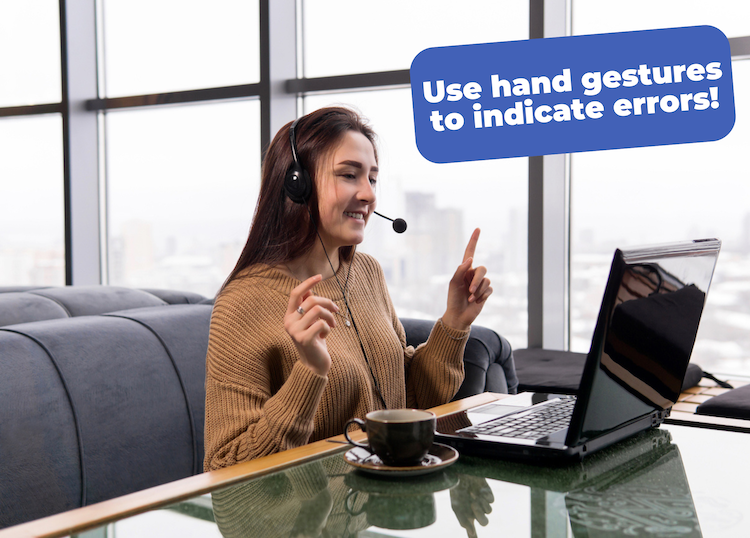
Some effective techniques::
- Gestures and visual cues. Instead of saying “That’s wrong,” use facial expressions, finger corrections, or pointing to visuals to guide students towards the correct form.
- Modeling the correct structure. Repeat what they said, but correctly, and emphasise it so they hear the right version. For example:
- Student: “She like pizza.”
- Teacher: “Oh, she likes pizza! Me too!”
- Choice-based correction. Give students options instead of an open-ended correction.
- Teacher: “She like… she likes or she liking?”
- Student: “She likes!”
For word order errors, one very effective technique is using your index fingers and crossing them while repeating the mistake to the student. So, for the example, “Came to the party my friend”, you can try repeating the error out loud, and then moving and crossing your index fingers. This is a clear way to indicate word order. Then allow the student to make the correction. This technique doesn’t apply just for beginners, and works well with higher levels as well.
One thing to avoid at this level is peer correction. Asking beginners to correct each other is like asking someone who just learned to ride a bike to teach someone else—it’s unfair pressure. They simply don’t have the awareness to spot mistakes yet.
Correcting Advanced Students: Push For Precision
When students reach upper-intermediate level B2 and beyond, they already have strong communication skills, but small mistakes can still affect clarity and professionalism. At this level, we expect them to take responsibility for their accuracy.
Some effective techniques for advanced learners:
- Metalinguistic feedback: Instead of correcting them directly, give them clues.
- Student: “If I would have more time, I would travel more.”
- Teacher: “Hmm… what’s the rule for second conditional?”
- Student: “Oh! If I had more time, I would travel more!”
- Peer correction: Now is the time to let students correct each other. They have the knowledge to do it, and it encourages active listening.
- Teacher: “Find 3 mistakes in your partner’s paragraph and help them fix it.”
- Precise feedback for subtle errors: Instead of focusing on basic mistakes, advanced learners benefit from feedback on things like tone, register, and natural phrasing.
- Student: “This book is very interesting and I like it so much.”
- Teacher: “Instead of ‘so much,’ a more natural way to say that would be…?”
At this stage, corrections should be challenging but constructive. The aim is to refine their language. So next time you hear a beginner say “She like pizza,” or an advanced student say “If I would have more time…” remember that how you correct them can make all the difference.
What exercises can my ESL students do at home to reinforce the corrections?
Error correction doesn’t end in the classroom. To make progress, students need to actively work on their mistakes at home. Here are some simple but effective exercises they can do on their own.
✅ Shadowing exercises
Students can listen to a short audio clip and repeat what they hear at the same time, mimicking pronunciation and rhythm. This helps with fluency and accuracy, especially for pronunciation mistakes. TED Talks, podcasts, and YouTube videos work well for this.
✅ Transcription practice
Ask students to transcribe a short segment from an authentic audio source, like a news clip or interview. Then, they can compare their version to the original. This improves listening skills and noticing errors in sentence structure.
✅ Grammar-focused activities
Students can use interactive grammar correction tools, like Grammarly or QuillBot, to check their writing. Another simple activity is error transformation: they take an incorrect sentence from their notes and rewrite it correctly in different ways to reinforce the correct structure.
💡 Pro Tip for Reinforcing Error Correction!

If you notice a student consistently struggling with a particular grammar point—such as verb tenses like the present simple, past simple, or present perfect—it’s a great idea to build, find, and use future lessons around that specific challenge. By directly addressing the language points your student is having trouble with, you can help reinforce correct usage and gradually eliminate the recurring mistake.
Fluentize makes this easy. Our extensive library of lesson plans is designed to target a wide variety of grammar and language skills in a fun, engaging way. Just search for the grammar point your student needs help with, and you’ll find ready-made materials to support their progress.
Plus, each lesson is built around a real YouTube video to keep your students motivated and learning in context!
One more note about error correction…
It’s important to remember that not every single mistake needs correcting. Over-correcting can lead to confidence issues in students and really disrupt their fluency. If you’re constantly focused on correcting their errors, it also makes communication unnatural. It’s ok to let some mistakes go sometimes. It’s great to be attentive to the mistakes your students are making, and error correction is one of the most important skills you should develop as a teacher. However, we also need to take student confidence into account!
Final Thoughts on How To Correct ESL Students’ Errors
Errors are a natural part of learning. If students feel anxious about making mistakes, they may avoid speaking altogether. That’s why it’s essential to normalize errors as part of the learning process. Teachers can do this by celebrating progress instead of perfection. Instead of focusing only on mistakes, highlight what students did well. A simple phrase like, “Your sentence structure was great! Just one small fix…” keeps motivation high. Ultimately, mastering how to correct ESL students’ errors is about building a learning environment where students feel safe to experiment, make mistakes, and grow.


